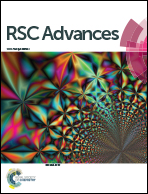L-Methionine based phenolic compound mediates unusual assembly of AgNPs and exerts efficient anti-biofilm effect†
Abstract
2-(2-Hydroxybenzylamino)-4-(methylthio)butanoic acid (L) together with capping molecules, produced AgNPs with unusual nanostructures that showed efficient inhibition of biofilm growth. Nanoplates of AgNPs self-assemble into micron sized flower-petal like structures in L–PSS–AgNPs whereas mesocrystals with visible voids from smaller nanoplates formed in L–SDS–AgNPs. L–PVA– and L–PVP–AgNPs showed polydispersed multi-shaped nanoparticles including nanoprisms, spheres and plates. Structure–property studies indicate that slow reduction of Ag+ ions and thiophilic interaction of L is responsible for the unusual morphology and organization of AgNPs. Importantly L-capping molecules–AgNPs exhibited strong biofilm inhibitory effect against four different bacteria, S. aureus, P. aeruginosa, B. subtilis and E. coli of which, the former two are classical colonizers in burn wounds. BIC (biofilm inhibitory concentration) and MIC (minimum inhibitory concentration) studies further confirmed the true anti-biofilm effect of AgNPs. Studies to unravel the mechanism of action indicated that the enhanced anti-biofilm effect could be attributed to altered membrane permeability and integrity caused by L, which in turn curtails bacterial colonization as revealed by confocal imaging. Thus a simple amino acid modified phenolic molecule exhibited an interesting assembly of AgNPs with remarkable anti-biofilm activity, which holds promise for its potential use in the fabrication of wound healing dressing materials.



 Please wait while we load your content...
Please wait while we load your content...